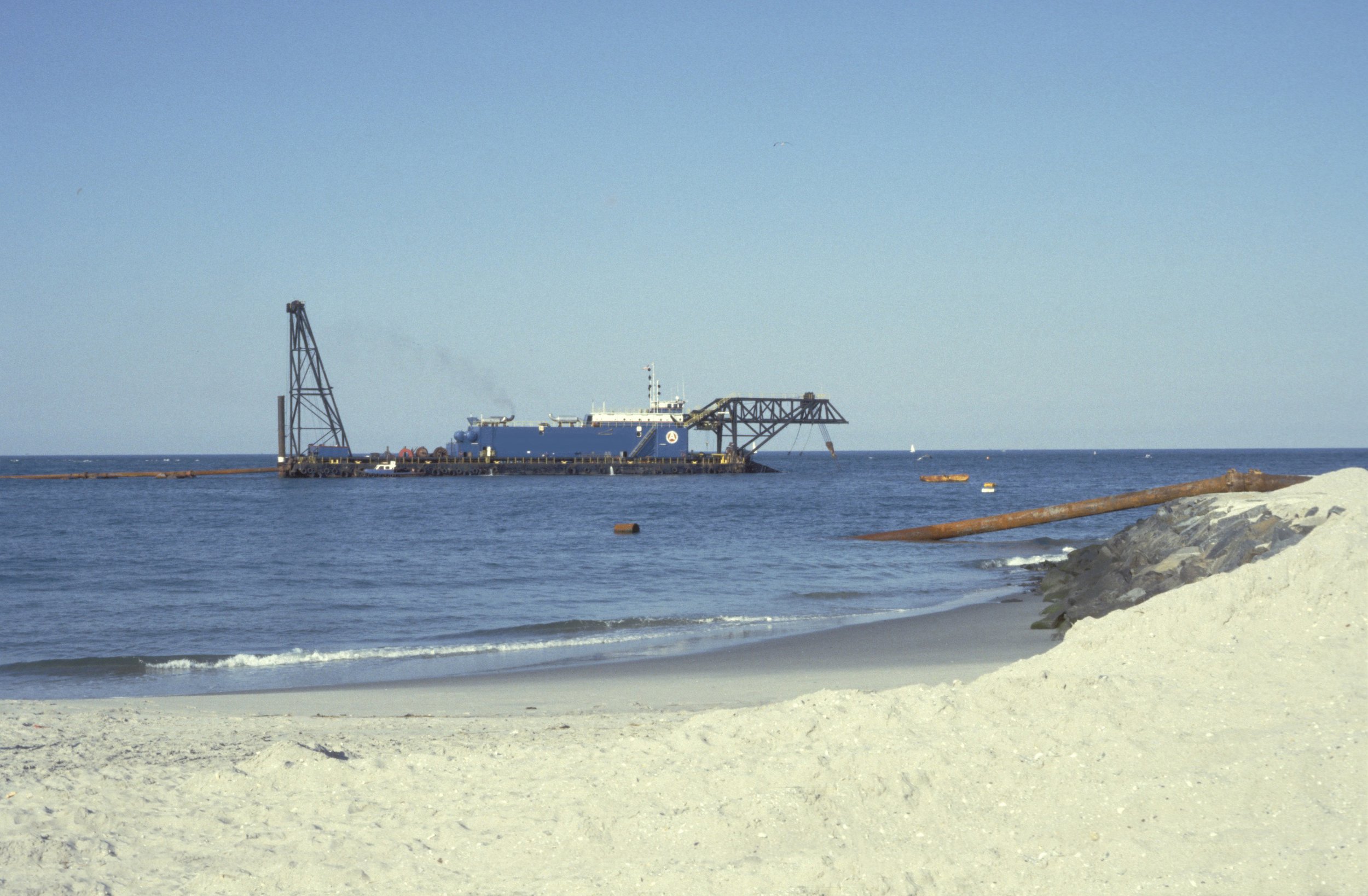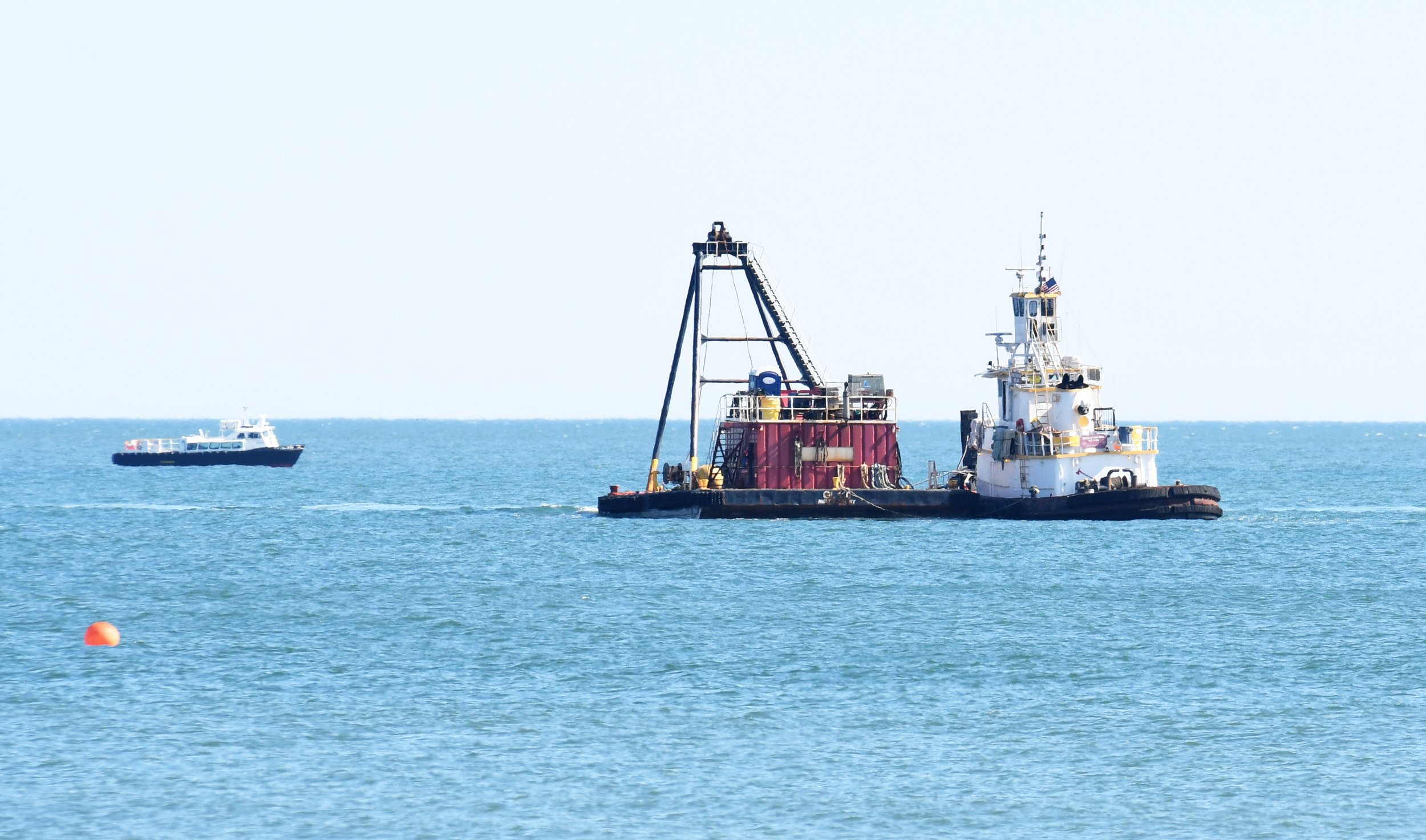Living on the Dredge: An Inside Look at the Rig and the People Who Shore Up Our Beaches
Sand is expected to be pumped 24 hours a day onto Avalon and Stone Harbor’s beaches.
Seven Mile Beach visitors embrace a rare phenomenon.
It might be the summer version of Christmas magic, in which wide, sand-fortified beaches resemble presents placed under the tree.
It might also be a work in progress, with sand being pumped in during the summer season, temporarily closing some beaches.
Both scenarios look possible with the 2023 beach-fill project in Avalon and Stone Harbor.
Projections indicate Avalon’s replenishment of approximately 600,000 yards of cubic sand should be complete sometime in April. Stone Harbor immediately follows suit for about 400,000 cubic yards, and it’s a coin toss on whether the project is complete before summer visitors come.
Unforeseen elements like weather, equipment issues, and possible project expansion impact timetables.
But this is an eye-opening process by any account. Somewhere in the neighborhood of 1 million cubic yards of sand will be pumped from Townsend’s Inlet onto Seven Mile beaches this spring.
In this 24/7 operation, the beach might receive between 35,000 and 40,000 cubic yards in a single day. Or about 3,000 dump trucks’ full.
How’s that for massive?
Why it matters
Dredging is the shorefront’s master shield, placing the next layer of defense against erosion and tropical storms onto the beach. Sand pumped from the ocean floor gives homeowners and businesses a cushion against Mother Nature.
The dredge is the edge. And for towns fortunate enough to line up a dredging schedule, the future is always now.
Few people know the dynamics of beach replenishment, other than the final result or the noise created by a 24-hour operation.
But those replenishing Seven Mile beaches this spring have their own form of variables, logistics and tough life choices.
Mike Hungerford and Kyle Bean, the respective manager and chief engineer of the 2023 project fortifying local beaches, shared their experience with Seven Mile Times.
They have a unique perspective on the job and the sacrifice connected with pumping sand.
Their journey is a hard one.
But it’s not “dredgery.”
Here’s an overview of the process, the dredge and the people who operate it.
The backdrop
It began early this year, when the U.S. Army Corps of Engineers’ Philadelphia District awarded a $28.8 million contract to Great Lakes Dredge & Dock Company of Oak Brook, Ill., to conduct the beach-fill project in Avalon and Stone Harbor.
The project is a joint effort between the U.S. Army Corps of Engineers, the New Jersey Department of Environmental Protection, and the boroughs of Avalon and Stone Harbor.
The contract calls for dredging sand from the Townsend’s Inlet borrow site. Sand is then pumped through a series of pipes, placed on beaches, and graded into an engineered dune and berm template.
The process is designed to reduce damages from coastal storm events.
In Avalon, the fill area begins at 8th Street and runs south to 32nd Street, according to the borough website.
Much of the fill will be placed north of 20th Street, as the extreme north end beach was eliminated during a nor’easter storm event last October. The stretch of the fill depends on the condition of the beach at the time of the project and the amount of sand available.
In Stone Harbor, sand will be placed from 90th to 123rd Street, according to the borough website. The contract currently calls for placing 464,000 cubic yards of sand. The contract includes options to place additional sand.
The numbers and scope may change, but the ballpark of 1 million cubic yards indicates a high-level project.
The 24/7 operation requires anywhere from 50 to 60 employees working offshore, on the beach and in points in between. Many operate in 12-hour shifts.
The Texas Dredge is the vehicle by which this materializes. Here are its specs:
Overall length: 355 feet
Breadth: 66 feet
Draft: 11 feet
Dig depth range: 15 to 94 feet
Suction diameter: 34 inches
Discharge diameter: 30 inches
The Texas is a cutter suction dredge. It has a rotating cutter head that excavates seabed material and, through a series of pipes and pumps, transports material to in-water or upland discharge locations. Analysts liken the cutter heads to an egg beater.
The dredge excavates and pumps a wide range of materials, including highly consolidated sand, clay, and rock.
The material comes out onto the beach as a combination of sand and water known as a slurry. Water gravitates naturally back into the ocean. Engineers then take the sand, bulldoze it, shape it, grade it, and essentially place it into formation on the Avalon-Stone Harbor beach.
The people behind the project
Hungerford, the project director for Great Lakes Dredging, personifies the unique commitment employees and management sign up for. Their lives resemble those of airline captains and flight attendants, multiplied a couple of times.
Like his employees, Hungerford is away on the road for a couple of weeks straight and then home back in Smyrna, Del.
Unlike many of them, he can leave the vessel, find a nearby company-approved location on shore, and commute to his workplace. Anywhere from 16 to 18 employees actually stay on the ship and work seven 12-hour days a week.
From either perspective, it’s an unusual challenge.
Hungerford balances this act with his wife Ashley, a nurse, and their two girls, Peyton, 13, and Maci, 10.
“You have to take time to make it work,” he says. “We are away from our families two-thirds of the year. When you are home, you are really home, spending time together and not working.
“It takes being a strong individual and accepting that you can’t be there for everything. At least now we have FaceTime and Zoom and things that can keep us all in touch when I’m not home.”
Hungerford stresses the perks of the job, like being able to see new places. Younger crew members enjoy the sense of adventure of working outdoors. Older employees like everything from the good pay to extended family time home every couple of weeks.
His entry into this realm was unexpected.
Hungerford had earned an engineering degree from the University of Delaware and wanted to work locally. He could have been designing roads, or other infrastructure-related plans and specs.
But then came 2008.
“Quite honestly, the recession is what happened,” he says. “I needed a job. I went on a job interview with Great Lakes Dredging and, well, it’s 15 years now.”
Fifteen years of handling a unique life. Hungerford has traveled up and down the East Coast, to Texas and around the world in Egypt, Saudi Arabia, Bahrain. Up to Canada. Down to Central America.
Professionally, he is one with the water.
Dredge, baby, dredge.
Logistics mark the job
Great Lakes Dredging handles nearly all the beach-replenishment projects in this area. It reports directly to the U.S. Army Corps of Engineers, which works with the towns to schedule projects.
Officials try to complete projects before tourists arrive, but that’s not always possible.
For that reason, Hungerford understands mixed public reaction to beach replenishment.
“Some like us being there, some hate us being there,” he says. “The towns like us protecting them, giving a beachfront that is good for their island. The tourists don’t like it when we are there if they are vacationing at that time.
“There is nothing we can do about when projects are scheduled.
“I like the challenge of doing this, and it has evolved over the years,” says Hungerford, who initially viewed his profession as designing roads, etc.
“Now you show up at a beach and it is in disarray from a storm. You work with a guy next to you. The efforts of you and that person help you complete this job, and when it’s all done, here is this nice, wide beach that people can use.
“Sure, I initially saw myself as designing things as an engineer. Now I am happy to be part of a team that is protecting the islands.”
Bean, chief engineer for the Texas, rarely mingles with the public. He occasionally hears a “Thank you” from a resident, but his work is mainly spent on the water.
A different scenario involving equipment can come up at any time, he indicates. That keeps the project interesting, an important characteristic, because much of this job resides between the ears.
“This is more of a mental thing, being away from normal everyday life, than a physical challenge,” says Bean, a native of southeast Georgia. “It can get stressful for a lot of these guys, being that there are things going on at home with family and there is nothing they can do.
“I am three weeks on and three weeks off. When I go back home, for the first two days my wife Ashley takes off for peace and quiet. This is usually difficult for everybody involved, but we make it work.”
Bean’s three children are being brought up under this arrangement. Logan, who will turn 5 in August, Hadley, who turned 2 in March, and Sadie, 8 months, get a full dose of their dad for three straight weeks. Then he’s back on the water, making a living.
It’s not easy for him either.
Bean works from 5 am-5 pm every day and then retires to a room that might be 6-by-8 feet or 8-by-8 feet. One would think that’s too tight, but “by the time you work that long, you don’t really want to do much but go back there and sleep,” he says. “They have a galley, they have a TV room for everybody and they are redoing their gym.
“Some guys out here have been doing it 30 or 40 years,” he adds. “I think they stay on because the benefits have gotten a lot better over the years and this is what they know. It is a comfort zone.”
Yes, the dredge is loud. For some, that can be disturbing. But out on the water, it has the opposite effect on Bean, like the noise from a major city not being there when someone wants to fall asleep out in the country.
“When there is no noise, I don’t sleep as well,” he says with a laugh.
For those involved with this work, it is completely opposite from the sunbathing experience felt by the consumers.
Most of the operation is offshore, during the offseason, and with sounds coming from the Texas Dredge, not a lifeguard’s whistle or the laughter of vacationing children.
It’s not an easy way for someone to literally travel the sands of time.
But without this process, and unique collection of people who do it, the beaches as we know them would not exist.
Their persistence can change a beach, like magic.





